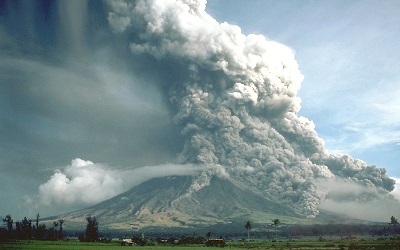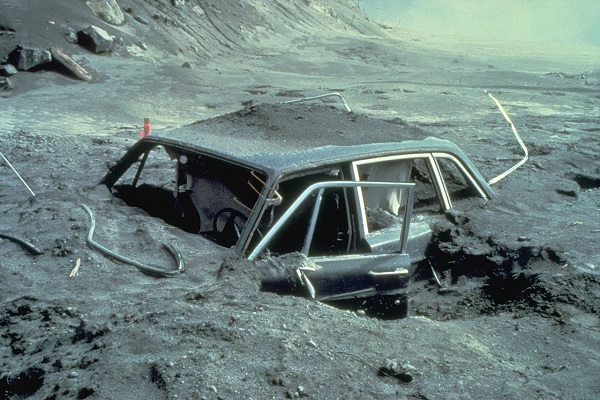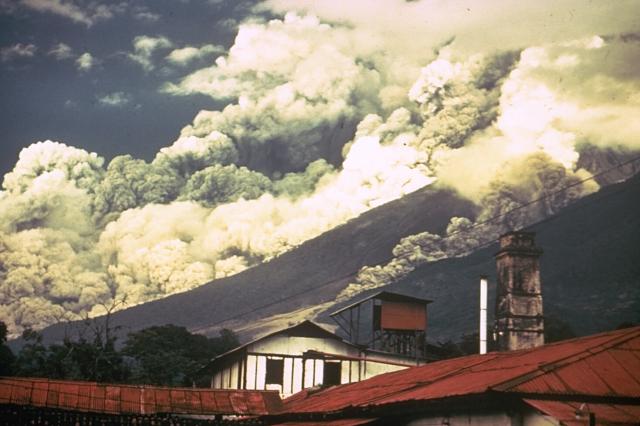| Design solutions can prevent death and injury in volcano areas, particularly in low-income areas that rely on cheap materials and design methods. These considerations are vital when planning out a community, arranging societal connections, and especially for people unable to evacuate a disaster zone.
Volcano ash is treated a lot like snowfall, except for some key differences. It is more than twice as heavy as snow, it is corrosive, the air is potentially toxic, and the eruption brings with it a series of other disaster events, such as a much more severe wind force. Structural DesignDistance from a volcano is not very relevant. Proximity to lava and pyroclastic flow zones will determine what will happen. But as far as falling ash is concerned, prevailing winds, topography, and chance determine areas that will be affected. |

|
Evacuation Route – The most important thing in an eruption is to evacuate. Site locations need to be selected based on their practicality to evacuate the area, and evacuation methods need to be readily accessible. Windows should efface the volcano so people inside could see if it erupts (it is also a nice view), and warning systems should alert residents who might be sleeping that they need to get out now. People need to flee to safety during the precious seconds while they still have time.
Lateral Support – Prevailing wind becomes a more important issue, as eruptions whip up a fierce storm and the flying mud applies a much greater lateral force. Researchers found that buildings with steeply sloped roofs were much more likely to fail in the Mount Pinatubo eruption of 1991. This might seem counter intuitive when you consider that more ash settles on flat roofs, but it might have been wind blowing against steep roofs that caused them to fail. One-third of building affected experienced collapsed in the Mount Pinatubo eruption.
Triple Roof Support – Snow weighs 50-300 kg/m3, but ash is 400-700 kg/m3, or more than double that if saturated with rain. This means more than triple the weight of the thickest snow on the roof, and there is no telling how much ash will get dumped on the roof.
Hopefully ash is the worst that will happen. Flying boulders are much harder to design for.
Covered Areas Still Vulnerable – The fierce winds will also blow a lot of this ash sideways, so it will get under overhangs and smash out windows. Covered outside elements such as balconies, car ports, and decks need additional support. Windows need shutters to help seal them airtight. Imbricated roof tiles allow blown ash to accumulate and weigh down the roof, so don’t use them.
Steep Slope Roof – Researchers in New Zealand found that metal roofs with 15o slopes retain most of the ash that fall on them. Roofs with a 25o shed some of the ash. Roofs with a 45o shed most of the ash. As long as they are well laterally braced, steeply sloped roofs are preferred. Wet ash accumulates 15 cm on a sheet metal roof of a 25o slope. This is still up to 30 kg/cm2!
Smooth Roof Material – As with snow, smooth roof materials will slide the ash away and avoid the complicated assembly that accumulates additional ash. Imagine you dumped two feet of dirt on your roof. Would it slide off?
Concrete Structure – Researchers of the Mount Pinatubo eruption found that timber framed buildings were much more likely to fail, and that reinforced concrete fared the best. Concrete is suitable against the wind and earthquakes associated with volcanic eruptions.
Short Spans – Researchers of the Mount Pinatubo eruption found that roofs with long structural spans were five times more likely to fail.
Simple Geometry – Keep the corners and turns as simple as possible on the structure. Ash will settle at chimney flues and roof interfaces, much like snow. Avoid complicated shapes and materials that not only capture ash but are susceptible to wind damage.
Gutters and drain systems are almost certain to become clogged, so install them in such a way that accumulating debris will not stack on top of the roof and contribute to major structural collapse. My rule of thumb is to avoid gutters if possible, as they can lead to problems in many kinds of ways.
Pyroclastic Flows
Often, hot gas and rock combine in an eruption and flow down the side of the mountain like an avalanche. The pyroclastic flows move extremely fast, up to 450 mph and achieve temperatures of 1,000 °C. This is the biggest danger in an eruption, short term.
The simple answer is to not be downstream from the mouth of a volcano. Avoid valleys and evacuate as soon as possible. But otherwise, there is not much you can do against this force. It will destroy anything in its path. The speed will be greater if the mountain slope is steeper. Also, don’t think you are protected by rivers or lakes. Pyroclastic flows can cross water.
Lava flows are much slower. But they can still be deadly if people don’t know they are coming.
Seal Air Space
Even when it isn’t erupting, and often while they are erupting, volcanoes could release deadly gases. This is why it is important to seal all windows and openings to the building. Make the building’s airspace completely isolated. Consider mechanical systems and air intakes and how to seal them off. Fierce winds whip up debris and smash through windows, so thick shutters will be needed to protect them.
The ash from volcanoes is potentially toxic and could lead to serious long-term illness, so masks need to be worn as long as ash is still around. If certain ash gets wet from rain, it could be highly corrosive acid, which is very deadly if consumed. Gas masks or oxygen storage should be considered in the building’s store of emergency supplies, especially if it is in a valley where carbon dioxide could settle.
Corrosion
Ash usually contains acid. The hydrochloric and hydrofluouric acid becomes sulphuric acid when mixed with rain water, which is very corrosive to buildings. It probably will not corrode through a sheet metal roof while the eruption is happening, but considerable corrosion can be expected if the ash is still there after a month.
Experts recommend that all outside electronics such as alarm systems and door openers be wrapped in plastic to avoid corrosion and electronic discharge. Mouths and human openings should be covered, of course, to avoid ingestion of the acid. This is harder than it sounds when you have wet mud being blown in your face. This is why precautions should be taken before the disaster happens.
Secondary Events

A series of other disasters accompany events. Earthquakes, tsunamis, mudslides, avalanches, and fires often result. These events should be considered in the design of buildings and community organization. Luckily, many of the same design solutions will help with these other disasters.
Community organization will help people quickly evacuate, and this will be critical in the case of an eruption as the secondary events typically come later. It is also important to note that these secondary events could effect areas far away and much later, such as a tsunami on the other side of the ocean.
After Volcano
The long-term effects of volcanic eruptions cannot be understated. Devastation of agriculture could lead to famine. Poisoning of water sources could lead to drought. Air conditions could lead to widespread health problems. Volcanoes have historically been known to wipe out entire civilizations in the long term.
Community emergency response plans provide evacuation routes, so displaced populations can be provided for as refugees in a nearby safe location. This requires emergency supplies, housing, and services. On a smaller scale, this involves awareness of your neighbors and planning with your own family what to do in case of an emergency. Individual households should keep a reasonable supply of food and equipment that would be needed to cope long-term in a situation such as this. A supply of canned food, first aid, masks, eye protection, back-up power, and water are reasonable. More expensive items, such as water-testing equipment, will probably need to be maintained on a community basis.
Ash needs to be cleared away as soon as possible. Corrosion and continued collapse risk need to be taken care of. It is slippery so be extra carefully walking around, and remember to protect the mouth and eyes. Search and rescue is also a top priority for those who are missing. A viable community emergency plan goes a long way in dealing with the days and years after such an enormous disaster.
Images: C.G. Newhall on wikipedia/public domain
William Buell on wikipedia/public domain
Philippe Vieux-Jeanton on flickr/public domain
Danial Dzurisin on wikipedia/public domain


